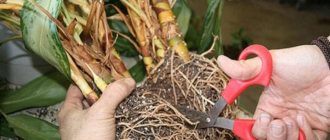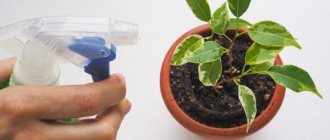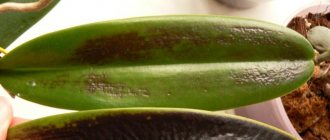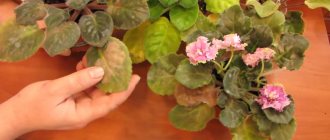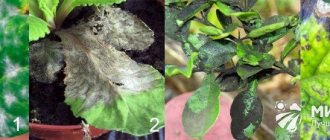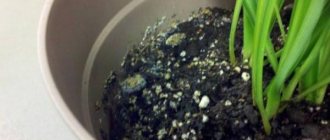Problems with leaves: why they wither, where the spots come from
Healthy orchids have dense green leaves that are quite large in size. If the leaves of a plant have changed color and structure, this indicates a disease of the plant.
Why do leaves lose their elasticity (turgor)?
Turgor - loss of leaf elasticity - the result of various errors in care
There may be several reasons:
- Temperature too high. When the plant is exposed to the sun for a long time, the leaves actively lose water. The soil also heats up and evaporation forms in it . The underground roots do not have enough moisture, and, oddly enough, they become overcooled, since the heat of the soil is spent on evaporation.
In order for the plant to be rehabilitated, it must be protected from direct sunlight, while providing enough daylight.
After the temperature between the roots and leaves has normalized, you can water or wipe the leaves with a damp cloth. You can add a little orchid to the water
- Hypothermia. When choosing a place for a plant, be sure to beware of drafts: they lead to freezing of the leaves. For an orchid, frostbite will occur at temperatures below 15 degrees.
It will not be possible to cure it; you will have to cut out the damaged tissue. To avoid such unpleasant consequences, place the flower away from drafts, and in frosty winter, place it further from windows.
- Pests. Mites and mealybugs may appear on the leaves , it withers, and the leaf loses its hardness and color.
Washing the plant from the outside will help solve the pest problem. Thoroughly clean the surface of the leaves to remove pest eggs.
Sticky leaves are a direct sign of spider mites.
If the orchid is occupied by a spider mite, then you can get rid of it by increasing the air humidity : place the pre-watered flower in a plastic bag. However, in this case, protect the orchid from the sun, otherwise harmful evaporation will occur.
The mealybug feeds on plant sap. In addition, it injects poison, poisoning the orchid, and its habitats become sticky.
What to do to save an orchid from a pest? First, you need to isolate it from other flowers . Then remove the scale insect from the surface and apply insecticides to the cleaned leaves.
Don't rely solely on chemical exposure: mites and other pests quickly adapt. Fight them comprehensively.
Preventing a flower disease is always easier than treating it later. Therefore, it is imperative to inspect the flower daily in order to stop the proliferation of the pest in time.
- Lack of moisture. The main rule for watering an orchid is to water only dry soil . Watering is best done by immersing it in water for one hour.
The composition of the substrate influences the degree of flower moisture. Unsuitable bark will not absorb moisture, and water will not be able to stay in the plant. In this case, the plant must be transplanted into a good substrate.
For orchids, bark from cut logs or dead pine, or any coniferous species is suitable. There should be no resin in the bark.
Why do phalaenopsis flowers dry out?
The reasons for the short life of a flower or bud may be the above-mentioned problems with leaves: pests, incorrect temperature conditions and watering conditions for the orchid.
Placing an orchid in the sun is a direct violation of the temperature regime, which has a bad effect on the flower.
We have already found out what needs to be done to cope with these problems. However, a number of features should be highlighted .
| If an orchid has been blooming for a long time, it may simply fade and go into a dormant period. | This is a normal process and there is no need to worry |
| Pollination of a flower by flying insects | If pollination fails, the flower will wither and fall off |
| Being near vegetables and fruits | They secrete substances that activate the ripening of flowers, even those that have not yet opened. This provokes the death of inflorescences |
| Artificial heating | Hot air dries out flowers and unopened buds. In this case, place the plant away from dry air flow |
| Stress | If the orchid was recently brought from the store, the flowers may wilt due to stress. The plant could have been poorly packaged, especially in cold weather: an orchid can drop its flowers even at zero temperatures. |
Therefore, when purchasing, be sure to protect the flower from the cold. Flowers should also be protected from the bright summer sun with a simple paper bag.
Causes of spots
The reasons why white or other spots appear on the trunk of an orchid or on its leaves are bacterial, viral, and fungal infections.
The source of infection is most often the soil. Unsuitable maintenance conditions can provoke the appearance of spots on phalaenopsis: dryness or excessive humidity in the room, a dark place or short daylight hours, location close to a heat source or cold glass. Another reason for the spread of the disease is a nearby plant infected with a virus or bacteria. This is why phalaenopsis cannot be placed with other flowers.
The treatment of the plant depends on which characteristics best suit the description. It is also possible to predict the recovery period and the likelihood of resumption of flowering.
What other problems can the leaves develop?
Dark spots or dots: what to do
What diseases are indicated by darkening of the leaves of the plant?
Hives. Dark lesions appear almost immediately after infection. They are small (up to 3 mm), round in shape. They quickly spread throughout the flower. The reason is low temperature, excessive humidity , and insufficient ventilation.
Bacillus Cypriped or Brown Rot. A dangerous, common disease of orchids. Caused by a pathogenic bacillus. A favorable environment for its reproduction is high temperature and humidity. At first the stain is small and light, then it darkens and smells unpleasant.
Black rot, like any other type of rot, threatens the plant with death
Black rot (Phytophthora) is one of the most serious diseases that affects orchids. First, purple spots appear on the leaves, which gradually darken and turn black. This disease occurs due to excessive watering and too dense soil.
Phyllosticosis. The infection affects the leaf blade, which dies . Phyllosticosis manifests itself in different ways: from small black spots to large black spots.
Burkholderia gladioli. A bacterial disease that occurs at high temperatures and high humidity. Decay occurs very quickly. It appears as dark brown wet spots.
The same fungus can be individually expressed on a certain type of orchid. The manifestations of the vital activity of the fungus depend on the quality of the leaves and on the systematic care of the plant.
In addition, several pests can simultaneously develop .
White spots on leaves
If the leaves begin to turn white in spots or spots, this may occur for the following reasons:
Excessive watering. Upon contact with water, white spots form on the leaves. Nothing can be done about this; the spots will remain on the leaves.
Burn or excessive dryness. These reasons lead to the appearance of wet white spots. Damaged leaves must be removed.
White spots on the leaves are one of the signs that the plant has been attacked by a fungus
Fungal disease. It appears as white spots, similar to a burn. Fungal diseases can only be fought with special means . With timely measures taken, the plant can be rehabilitated.
Black leaves
In addition to the damage already described by fungal diseases, the leaves may turn black and die. Why might this happen?
- Some types of orchids, after the flowering period, shed their leaves, which first turn black.
- Incorrect temperature and watering conditions for the orchid
- The leaves of the plant can be infested by mites; they are often located on the inside of the leaves.
Loss of leaf elasticity and density
Loss of leaf turgor is characteristic of problems with roots:
Overheating of roots and excessive or insufficient moisture. In this case, leaf turgor is not maintained, and the orchid will begin to fade.
Remember - even special fertilizers can be harmful in high concentrations
Incorrect feeding. Don't overdo it with fertilizers . Orchid roots are very sensitive; excess nutrients are detrimental to the orchid.
The soil is too dense. If the orchid is not replanted for a long time, the soil becomes compacted and oxygen access deteriorates.
Why is it dangerous?
The appearance of white plaque can be caused by two reasons, each of which poses a mortal danger to the plant:
- The plant may be infected with powdery mildew. In this case, a coating similar to a thin layer of flour initially appears on the underside of the leaves. As the mycelium ages, the plaque turns a dirty gray color and the stain becomes moist. If measures are not taken, the fungus gradually spreads to the upper part of the leaves, buds, inflorescences and roots. The affected areas become deformed and after some time begin to rot. Without treatment, the plants may die.
- An orchid can be attacked by a mealybug. This insect is covered in protective white hairs, and the coating on affected leaves looks like tiny flakes of cotton wool. The pest drinks the orchid juice, injecting back toxic substances, causing the plant to weaken, slow down development and become more vulnerable to infections. In addition, a sooty fungus, which also poses a danger, likes to settle on the sticky secretions of the insect. If measures are not taken, the leaves become deformed and marbled red and yellow stains appear on them. Photosynthesis is disrupted, the plant weakens more and more and eventually dies.
Problems with orchid roots: drying out
The color of the roots of an orchid depends on the specific species, fertilizers and complementary foods. Some species have naturally dark roots, but this does not indicate that they are painful.
To assess the condition of the roots, you need to carefully remove the plant from the pot, free the root system from the soil and inspect the roots. If they are firm, they are healthy. If the root seems hollow inside, it dried out irrevocably .
Orchids have two types of horses: aerial and underground (internal). Underground are found in the substrate. Aerial roots are those that are located outside the soil. This is the norm for an orchid.
Aerial roots are important for the proper photosynthesis process of the orchid.
Causes of drying out of underground and aerial roots
- Chemical burn from hard water and fertilizer salts.
Incorrect watering. Why roots dry out when there is not enough water is obvious. If you keep the root system in constant moisture, the roots will die and, oddly enough, they will dry out or rot.
- In most cases, white roots indicate that the plant was mercilessly flooded with water and is not participating in photosynthesis.
- Dry air.
- Injuries. The roots are easy to break . Even a minor scratch will cause the root to dry out.
- Life activity of fungi.
If formed on the underside of the leaf
In fact, it doesn’t matter where exactly the color and structural defects occurred on the orchid leaf. In all cases you need to act the same way:
- Examine the plant carefully and try to determine the cause of the spots.
- If the cause is a pest attack, then you need to get rid of them first. Often the orchid is treated with a soap solution and then with an appropriate insecticide.
- If the cause is a disease, then you need to study possible methods of therapy in this case and carry out all therapeutic measures as soon as possible before it is too late and the plant dies.
For more effective treatment, it is better to use a combination of traditional methods and chemicals.
What to do with soft and limp roots
As soon as a gardener is faced with sluggish and soft phalaenopsis roots, the question arises - what to do? Below we provide step-by-step instructions:
- Free the plant from the substrate.
- By placing the plant in water, it will become clear which roots or parts thereof have dried out. All dead areas are cut back to the living root. Treat the cut area with cinnamon or charcoal .
- To help the flower produce new roots, prepare warm, soft water. You need to place an orchid in it. Repeat the bath every day, leaving the flower in the water for an hour. After moistening, be sure to dry the orchid.
You can use succinic acid, which stimulates root growth . As an alternative, use Epin or other growth stimulants in low concentrations.
- After the new roots reach a length of 5-6 cm, the flower is placed in a pot with a substrate.
Don’t be afraid to try to prepare the substrate yourself - the main thing is to follow the proportions.
To prevent diseases from occurring on your orchid, just follow three simple rules: keep the flower in a bright place, monitor the air temperature and follow the watering regime. The rules are very simple ; if followed correctly, the plant will delight you with regular flowering and health.
Prevention
- The cause of infection of flowers may be improper care or the initial predisposition of the variety to the disease.
- For prevention, you can use special granules, which are purchased at flower shops. They are placed in the ground during plant transplantation.
- You also need to observe the temperature conditions and humidity in which the plant should live. It is best to place the orchid on a west-facing window with good lighting. Humidity should not be below 70%.
- Dead parts of the flower should be removed in a timely manner, and the plant should be treated more often, regardless of whether it is sick or not. Sometimes orchids benefit from a hot shower, but make sure the water temperature does not exceed fifty degrees.
- Be vigilant already at the stage of purchasing a plant. If you see that a flower is infected, it is better not to purchase it.
Follow preventive measures and do not cause plant diseases, then they will delight you with their beauty for many, many years.
